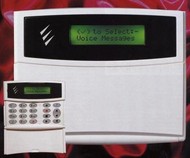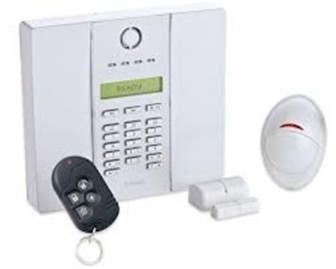Wireless Alarms Liverpool. HISTORY AND JARGON
0151 4762421
history, the burglar alarm system
A bit Of history on Burglar Alarms
On June 21, 1853 the first electro magnetic burglar alarm patent was issued to Augustus Pope. It operated off of the use of a battery and was an individual unit for each window or door. The bell, which rang from an electric current streaming through a magnet causing it to vibrate, was mounted on top of the door frame into the wall. Wires ran from a spring "key" in the door/window through a circuit breaker near the bell, allowing the current to run constantly once the door/window tripped the spring. This electronic version of an alarm system is a great improvement on the previous bell systems where clock work and other devices were used to ring a bell less efficiently.
On October 11, 1853 in the same town of Somerville, not too longer after Augustus' patent, G.F. Milliken filed a patent for the improvement on this ground breaking electro-magnetic alarm. He designed the alarm device to reside in the room where the homeowner sleeps or is unaware of potential thieves forcing entry. As well, he runs the wires from all windows and doors, not just one. Each door/window has a spring with a certain amount of creases that signify a specific number of rings on the bell, alerting the homeowner of the precise doow/window where entry has occurred. These devices and improvements have lead to strength in home security technologies which can be trusted by all.
The electric burglar alarm patent was then purchased by a shopkeeper named Edwin Holmes in 1858, and Holmes set up a company to install and operate electric burglar alarm systems in Boston.
In 1859, Holmes moved to New York, where The Holmes Burglar Alarm Company grew and expanded into other cities. One burglar alarm system comprised of a number of contacts that were placed on windows, doors, safes, and other possible points of entery or interests of theives. If a contact were disrupted, then the electric current running through the wires connected to the alarm would cause it to sound off. The company has been successful so far, and is growing at a rapidly increasing rate due to the success of Holmes' current electric alarm.
its all about the jargon
Any home alarm system consists of three basic components - Sensors, Control Unit and Output devices. The difference lies in the way the combination of the three is achieved. Burglar systems contain sensors, which are connected to a control unit through some low voltage hardwired or RF signals. The control unit is connected to an interactive voice response device for raising alarms. This type of burglar alarm systems can be used in a building or in corridors ,etc. However, when the detection is to be done in the house, motion detectors are used. Best example of motion detector is the automatic door. Whenever there is the signal from the motion detector to the control unit is cut or disconnected, the control unit senses the change and the specified action is taken. Ultrasonic sensors, microwave signals, RF signals, etc are used to achieve the level of sophistication needed to make the system completely error-free.
|
Security alarm systems seem to be getting more complicated. Whether you’re a homeowner, a key–holder at work, or you’ve some responsibility for your organisation’s premises, you’ll need to know a bit about your alarm system. So if you don’t know your PIRs from your PA Buttons, here’s a bit of jargon–busting… Magnet Reed ContactsOften used in homes on doors. Basically these involve two metal strips which, when they come together, complete a circuit. When the door is opened the circuit is broken and the alarm is activated. PIRs (Passive Infra Red Movement Detectors)Mainly used in domestic or office settings and positioned high up (usually in corners) to detect movement. They can spot the difference between humans and other intruders – such as mice – to avoid false alarms. Dual Technology Movement DetectorsThese combine infra red and microwave technologies. Both have to be activated making false alarms very unlikely. Vibration DetectorsNormally fitted to door or window frames. They detect high and low frequency vibration and can be adjusted to suit local conditions. BGDs (Break Glass Detectors)Usually fitted over or next to shop fronts. They detect the sound of breaking glass and any accompanying change in air pressure. Infra Red BeamsYou’ll have seen these in the movies! Thin beams of light that trigger an alarm when broken. Dual or twin beam units are sometimes used – both have to be interrupted to set off the alarm. They can be used inside or outside. PA (Personal Attack) ButtonsUnits with two buttons that must be pressed at the same time to activate an alarm. They can sound an audible alarm, or silently alert an ARC (Alarm Receiving Centre) – a place where remote monitoring is provided by the security system provider. |
myths about alarm systems
Myth #1: Affordability of the system.
The need of the system depends upon the things to secure. If valuables are kept in the house they need some protection for which we have to spend some money.
Myth#2: Misconstrued with insurance.
When I have insurance why I should go for home alarm systems is the normal question a skeptical person may ask. For them we may ask back when insurance is there, why we should lock our house. The concept of insurance and security are two different things which should not be mingled and confused. Insurance clauses get activated when you take all precautionary steps for the protection of assets and the loss has occurred despite all possible steps taken for the security.
Myth#3: Difficulty in operation and maintaining pass codes.
These are the things one has to do for the safety of the belongings. Another common doubt is about its workability in the absence of electric current. Nevertheless, modern alarm systems come with backup power and works on batteries. In fact, the power interruption the intruders attempt to make results in the form alarms being activated.


















